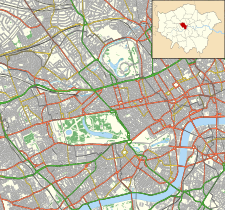
A hospital ship is a ship designated for primary function as a floating medical treatment facility or hospital. Most are operated by the military forces of various countries, as they are intended to be used in or near war zones. In the 19th century, redundant warships were used as moored hospitals for seamen.

Eliza Maud "Elsie" Inglis was a Scottish medical doctor, surgeon, teacher, suffragist, and founder of the Scottish Women's Hospitals. She was the first woman to hold the Serbian Order of the White Eagle.
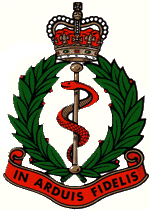
The Royal Army Medical Corps (RAMC) is a specialist corps in the British Army which provides medical services to all Army personnel and their families, in war and in peace. The RAMC, the Royal Army Veterinary Corps, the Royal Army Dental Corps and Queen Alexandra's Royal Army Nursing Corps form the Army Medical Services.

Wimereux is a commune in the Pas-de-Calais department in the Hauts-de-France region of France.
The Department of Soldiers' Civil Re-establishment was established by the Dominion Government of Canada in 1918 to handle the major problem of returning Canadian servicemen to civilian life after the First World War. In 1928 it merged with the Department of Health to form the Department of Pensions and National Health, with its former responsibilities being carried out by the Pensions Division.
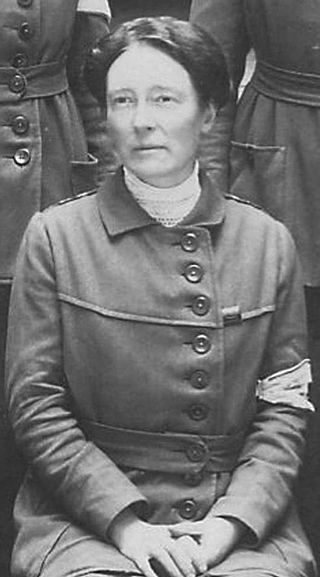
Louisa Garrett Anderson, CBE was a medical pioneer, a member of the Women's Social and Political Union, a suffragette, and social reformer. She was the daughter of the founding medical pioneer Elizabeth Garrett Anderson, whose biography she wrote in 1939.
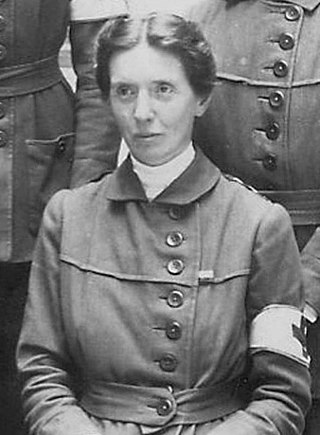
Flora Murray was a Scottish medical pioneer, and a member of the Women's Social and Political Union suffragettes. From 1914 to the end of her life, she lived with her partner and fellow doctor Louisa Garrett Anderson.

Vera Scantlebury Brown OBE was an Australian medical practitioner and pediatrician in Victoria, Australia.

Hôpital Temporaire d'Arc-en-Barrois was an emergency evacuation hospital serving the French 3rd Army Corps during World War I. It was organised and staffed by British volunteers and served French soldiers.

Beaufort War Hospital was a military hospital in Stapleton district, now Greater Fishponds, of Bristol during the First World War. Before the war, it was an asylum called the Bristol Lunatic Asylum, and after the war it became the psychiatric hospital called Glenside Hospital.
Helen Chambers CBE was a British pathologist and cancer expert whose findings on radium were essential in the fight against cervical cancer.
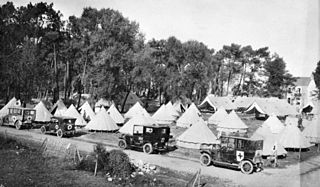
The Australian Voluntary Hospital was a military hospital staffed by Australian expatriates in England that served on the Western Front between 1914 and 1916. For most of the first year of the war, although not an Australian Army unit, it was an Australian presence on the Western Front.

Endell Street, originally known as Belton Street, is a street in London's West End that runs from High Holborn in the north to Long Acre and Bow Street, Covent Garden, in the south. A long tall narrow building on the west side is an 1840s-built public house, the Cross Keys, Covent Garden.

The Scottish Women's Hospitals for Foreign Services (SWH) was founded in 1914. It was led by Dr Elsie Inglis and provided nurses, doctors, ambulance drivers, cooks and orderlies. By the end of World War I, 14 medical units had been outfitted and sent to serve in Corsica, France, Malta, Romania, Russia, Salonika and Serbia.

Alexandra Mary Chalmers Watson CBE,, known as Mona Chalmers Watson, was a British physician and head of the Women's Army Auxiliary Corps. The first woman to receive an MD from the University of Edinburgh, she helped found the Elsie Inglis Hospital for Women, was the first president of the Edinburgh Women's Citizen Association, a staff physician and later senior physician at the Edinburgh Hospital and Dispensary for Women and Children, and co-edited the Encyclopaedia Medica with her husband, Douglas Chalmers Watson. At the time of her death in 1936, she was president of the Medical Women's Federation, having been elected May 1935.

The Scottish Women's Hospital at Royaumont was a medical hospital during World War I active from January 1915 to March 1919 operated by Scottish Women's Hospitals (SWH), under the direction of the French Red Cross and located at Royaumont Abbey. The Abbey is a former Cistercian abbey, located near Asnières-sur-Oise in Val-d'Oise, approximately 30 km north of Paris, France. The hospital was started by Dr Frances Ivens and founder of SWH, Dr Elsie Maud Inglis. It was especially noted for its performance treating soldiers involved in the Battle of the Somme.

Margaret (Madge) Neill Fraser usually known as Madge, was a Scottish First World War nurse and notable amateur golfer. She represented Scotland at international level every year from 1905 to 1914.

Eleanor Elizabeth Bourne (1878–1957) was the first Queensland woman to study medicine. She also was one of only 15 women doctors in Australia who volunteered for service in World War I.
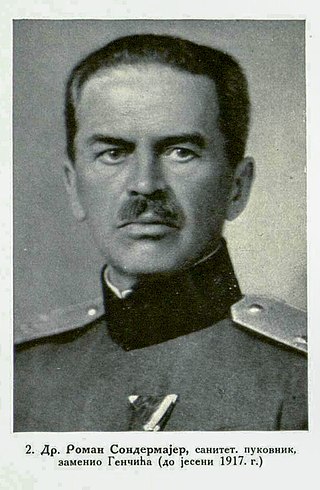
Colonel Dr. Roman Sondermajer CMG was a Royal Serbian Army physician who served as Chief Surgeon of the Royal Serbian Army, Chief Surgeon and Director of the Military Hospital and Chief of the Medical Staff of the Serbian Supreme Command during World War I.
Georgina Davidson MBChB was a Scottish medical doctor who served with the Scottish Women's Hospitals for Foreign Service in Serbia in World War I, and worked along with the Royal Army Medical Corps in war zone hospital services in Malta, Salonika and Constantinople. She was awarded the French Red Cross medal and the British War and Victory medals, and was mentioned in dispatches.

